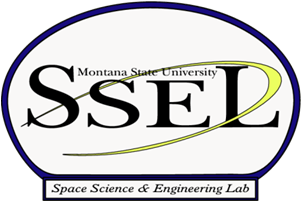Research Projects
Space Science and Engineering Lab|Experimental Space Physics|Solar Physics
Space Science and Engineering Lab

The Space Science and Engineering Laboratory (SSEL) place instruments into the environment to directly measure the plasmas, fields, and energetic charged particles in space or to remotely sense radiated emissions from distant plasma interactions. SSEL instruments are carried into space on satellites designed and built by SSEL students and staff, and by sounding rockets, and high altitude balloons. SSEL hardware has flown on NASA sounding rockets, NASA scientific research satellites, on International Space Station, and on our own small satellites to measure energetic charged particles and faint light emissions from plasma interactions in the ionosphere. X-rays generated in the upper reaches of Earth’s atmosphere in association with the intense belts of penetrating radiation that girdle Earth, are measured by instruments carried aloft on high flying stratospheric balloons. MSU-designed and built imaging spectrographic telescopes are flown on sounding rockets from NASA’s white Sands, New Mexico launch range to examine extreme Ultraviolet emissions from active regions on the Sun.
Experimental Space Physics
The Experimental Space Physics group seeks to understand the fundamental physics of space plasma interactions and the causes and the consequential
effects of extremely dynamic variations that give rise to constantly changing Space
Weather near Earth. The solar flares and coronal mass ejections studied by the Solar
Physics group disturb Earth’s magnetosphere and ionosphere. Along with a multitude
of other effects, energetic charged particles trapped in the Van Allen Radiation Belts
around Earth are destabilized causing some of them to rain down on the Earth’s upper
atmosphere, depositing energy and producing X-Rays as they interact with neutral atmospheric
atoms and molecules. Measurements made by the Space Physics Group contribute to further
understanding of these effects. Improved understanding will lead to better models
and, some day, to an improved ability to predict Space Weather events days in advance.
the fundamental physics of space plasma interactions and the causes and the consequential
effects of extremely dynamic variations that give rise to constantly changing Space
Weather near Earth. The solar flares and coronal mass ejections studied by the Solar
Physics group disturb Earth’s magnetosphere and ionosphere. Along with a multitude
of other effects, energetic charged particles trapped in the Van Allen Radiation Belts
around Earth are destabilized causing some of them to rain down on the Earth’s upper
atmosphere, depositing energy and producing X-Rays as they interact with neutral atmospheric
atoms and molecules. Measurements made by the Space Physics Group contribute to further
understanding of these effects. Improved understanding will lead to better models
and, some day, to an improved ability to predict Space Weather events days in advance.
Solar Physics
Solar Physics research overlaps with both Astronomy and Space Physics. It is astronomy because the Sun is a star. It is space physics because
the Sun is the source of the solar wind and disturbances within it that produce what
we know as space weather. The Solar Physics group studies the process of magnetic
reconnection as it occurs in solar flares and in the generation of coronal mass ejections
(CMEs) whereby vast amounts of magnetized plasma are launched into space. Solar Physicists
at MSU are actively involved in current and future NASA space missions, developing
new instrumentation, operating spacecraft on orbit, collecting and analyzing data.
They use spacecraft observations of the Sun in gamma rays, X-rays and extreme ultraviolet
to study these dramatic events. MSU researchers have pioneered techniques for using
spacecraft observations of these events to compute the electric field responsible
for them. They use this measurement to understand the energy release in flares and
the acceleration of mass in CMEs. They have also developed theoretical models to
explain how the energy stored in the Sun's magnetic field is rapidly converted to
heat, driving the flare plasma to temperatures above 40 million Kelvin.
Physics. It is astronomy because the Sun is a star. It is space physics because
the Sun is the source of the solar wind and disturbances within it that produce what
we know as space weather. The Solar Physics group studies the process of magnetic
reconnection as it occurs in solar flares and in the generation of coronal mass ejections
(CMEs) whereby vast amounts of magnetized plasma are launched into space. Solar Physicists
at MSU are actively involved in current and future NASA space missions, developing
new instrumentation, operating spacecraft on orbit, collecting and analyzing data.
They use spacecraft observations of the Sun in gamma rays, X-rays and extreme ultraviolet
to study these dramatic events. MSU researchers have pioneered techniques for using
spacecraft observations of these events to compute the electric field responsible
for them. They use this measurement to understand the energy release in flares and
the acceleration of mass in CMEs. They have also developed theoretical models to
explain how the energy stored in the Sun's magnetic field is rapidly converted to
heat, driving the flare plasma to temperatures above 40 million Kelvin.
